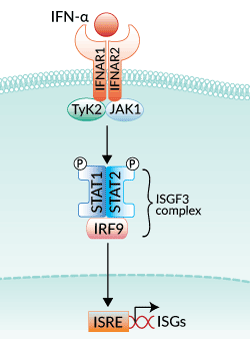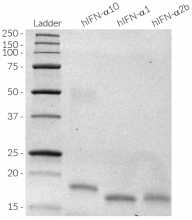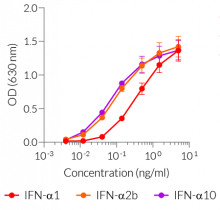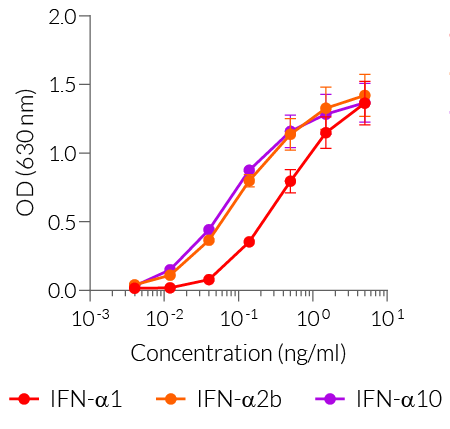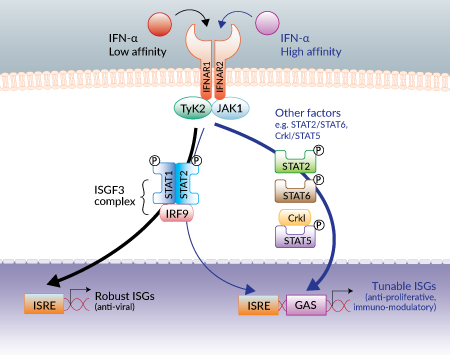Recombinant human IFN-α
| Product | Unit size | Cat. code | Docs. | Qty. | Price | |
|---|---|---|---|---|---|---|
|
Recombinant human IFN-α2b Mammalian cell-expressed human interferon alpha 2b (alpha 2) with HSA |
Show product |
1 µg |
rcyc-hifna2b
|
|
||
|
Recombinant human IFN-α1 Mammalian cell-expressed human interferon alpha 1 (alpha D) with HSA |
Show product |
1 µg |
rcyc-hifna1
|
|
||
|
Recombinant human IFN-α10 Mammalian cell-expressed human interferon alpha 10 (alpha C) with HSA |
Show product |
1 µg |
rcyc-hifna10
|
|
Recombinant human interferon-alpha 1, alpha 2b, and alpha 10 (with HSA)
Among the type I interferon (IFN) family, IFN-αs act as important anti-viral cytokines that also have anti-proliferative and immuno-modulatory functions.
InvivoGen offers three recombinant human IFN-α subtypes, which differ in their potency to induce the expression of IFN-stimulated genes (ISG) [1, 2]:
– Recombinant human IFN-α2b: the prototypic IFN-α used in fundamental research and most clinical applications [3, 4]
– Recombinant human IFN-α1: classified as the weakest ISG inducer [5, 6]
– Recombinant human IFN-α10: classified among the top three strongest ISG inducers [5, 6]
InvivoGen provides glycosylated recombinant human IFN-α2b, IFN-α1, and IFN-α10 that are produced in CHO cells. Production of recombinant proteins in mammalian cells ensures protein glycosylation and bona fide 3D structure. Of note, glycosylation stabilizes proteins against physicochemical instabilities.
 Available upon request:
Available upon request:
Other subtypes of IFN-α are available upon request for a minimum quantity.
Key features:
- Produced in CHO cells
- High-quality: purity ≥ 95% and endotoxin level < 1EU/µg
- Functionally tested
Applications:
- Cellular assays
- ELISA
IFN-αs provided by InvivoGen are for research use only.
References:
1. Schreiber G. 2017. The molecular basis for differential type I interferon signaling. J. Biol. Chem. 292:7285-94.
2. Manry J. et al., 2011. Evolutionary genetic dissection of human interferons. J. Exp. Med. 208:2747-59.
3. Paul F. et al., 2015. IFNA2: The prototypic human interferon. Gene.
4. Antonelli G. et al., 2015. Twenty-five years of type I interferon-based treatment: A critical analysis of its therapeutic use. Cytokine Growth Factor Rev. 26(2):121-31.
5. Moll H.P. et al., 2011. The differential activity of interferon-α subtypes is consistent among distinct target genes and cell types. Cytokines. 53:52-59.
6. Kurunganti S. et al., 2014. Production and characterization of thirteen human type-I interferon-α subtypes. Protein Expr. Purif. 103: 75-83.
Specifications
Recombinant human IFN-α2b
Source: Mammalian; Chinese hamster ovary (CHO) cells
Uniprot ID: P01563
Alternate name: IFN-alpha 2
Formulation: Lyophilized from a 0.2 µm filtered phosphate buffer solution (pH 7.4) containing 2% human serum albumin (HSA) and 5% saccharose.
Molecular mass: 17 - 20 kDa (SDS-PAGE)
Solubility: 100 μg/ml in water
Quality control:
- Purity: ≥95% (SDS-PAGE)
- Endotoxin level: ≤ 1 EU/μg
- The biological activity has been confirmed using HEK-Blue™ IFN‑α/β cells (see validation data sheet).
- The units have been determined for each lot using a corresponding calibrated standard.
Recombinant human IFN-α1
Source: Mammalian; Chinese hamster ovary (CHO) cells
Uniprot ID: P01563
Alternate name: IFN-alpha D
Formulation: Lyophilized from a 0.2 µm filtered phosphate buffer solution (pH 7.4) containing 2% human serum albumin (HSA) and 5% saccharose.
Molecular mass: ~ 17 - 20 kDa (SDS-PAGE)
Solubility: 100 μg/ml in water
Quality control:
- Purity: ≥95% (SDS-PAGE)
- Endotoxin level: ≤ 1 EU/μg
- The biological activity has been confirmed using HEK-Blue™ IFN‑α/β cells (see validation data sheet).
- The units have been determined for each lot using a corresponding calibrated standard.
Recombinant human IFN-α10
Source: Mammalian; Chinese hamster ovary (CHO) cells
Uniprot ID: P01566
Alternate name: IFN-alpha C
Formulation: Lyophilized from a 0.2 µm filtered phosphate buffer solution (pH 7.4) containing 2% human serum albumin (HSA) and 5% saccharose.
Molecular mass: 17 - 20 kDa (SDS-PAGE)
Solubility: 100 μg/ml in water
Quality control:
- Purity: ≥95% (SDS-PAGE)
- Endotoxin level: ≤ 1 EU/μg
- The biological activity has been confirmed using HEK-Blue™ IFN‑α/β cells (see validation data sheet).
- The units have been determined for each lot using a corresponding calibrated standard.
Back to the top
Contents
Note: Each product is sold separately.
Recombinant human IFN-α2b
- 1 μg of lyophilized recombinant human IFN-α2b.
- 1.5 ml endotoxin-free water.
![]() Recombinant human IFN-α2b is shipped at room temperature.
Recombinant human IFN-α2b is shipped at room temperature.
![]() Upon receipt, it should be stored at -20°C.
Upon receipt, it should be stored at -20°C.
Recombinant human IFN-α1
- 1 μg of lyophilized recombinant human IFN-α1.
- 1.5 ml endotoxin-free water.
![]() Recombinant human IFN-α1 is shipped at room temperature.
Recombinant human IFN-α1 is shipped at room temperature.
![]() Upon receipt, it should be stored at -20°C.
Upon receipt, it should be stored at -20°C.
Recombinant human IFN-α10
- 1 μg of lyophilized recombinant human IFN-α10.
- 1.5 ml endotoxin-free water.
![]() Recombinant human IFN-α10 is shipped at room temperature.
Recombinant human IFN-α10 is shipped at room temperature.
![]() Upon receipt, it should be stored at -20°C.
Upon receipt, it should be stored at -20°C.
Details
The human interferon-alpha family
Type I interferons (IFN) include the IFN-α family, IFN-β, IFN-ε, IFN-κ, and IFN-ω. IFN-αs are important anti-viral cytokines that also have anti-proliferative and immuno-modulatory functions. The human IFN-α family comprises 13 genes encoding 12 proteins, with IFN-α13 being identical to IFN-α1. All IFN-αs bind to a common heterodimer receptor IFNAR1/IFNAR2. The ternary complex signals through the Janus kinase (JAK) and signal transducer and activator of the transcription (STAT) signaling pathway, inducing the formation of the ISGF3 transcriptional complex (STAT1/STAT2/IRF9). ISGF3 binds to IFN-stimulated response elements (ISRE) in the promoter regions of numerous IFN-stimulated genes (ISGs) [1].
Human IFN-α genes have evolved under strong selective pressure, suggesting a non-redundant role between IFN-α subtypes [2]. Although most studies have focused on IFN-α2 and IFN-α8, a consensus model for all IFN-αs has emerged depending on the affinity of a particular IFN-α subtype for IFNAR. Low-affinity IFN-α subtypes signal strictly through ISGF3 and induce robust ISGs, such as PKR, ISG56, and IFI16, which display anti-viral functions. Conversely, high-affinity IFN-α subtypes signal through ISGF3 and other factors, which activate “tunable” ISGs” such as CXCL10, IL-8, and ISG15, that induce anti-proliferative and immuno-modulatory functions [3]. IFN-α8, IFN-α10, and IFN-α14 have been identified as the most potent inducers of ISGs, while IFN-α1 is the weakest [4].
Human interferon-alpha 1
Despite being encoded by distinct genes, human IFN-α1 and human IFN‑α13 display identical protein sequences [5]. Human IFN-α1 is induced in peripheral blood mononuclear cells (PBMCs) upon incubation with CpG-oligonucleotides and in plasmacytoid dendritic cells upon incubation with CpG-oligonucleotides or imiquimod [6]. Viral infection of PBMCs with herpes simplex virus (HSV), Newcastle disease virus (NDV), and respiratory syncytial virus (RSV) induce high production of IFN-α1 [7]. This subtype of IFN-α is classified as the weakest ISG inducer [4, 5] with the lowest anti-viral activity in vitro against the influenza A virus [5] and hepatitis C virus (HCV)[8]. Similar to IFN-α2 and α-8 subtypes, human IFN-α1 expression occurs early post-infection with Sendai virus in vitro, regardless of the viral multiplicity of infection (MOI), and may deliver a ‘priming’ signal to neighboring cells [9].
Human interferon-alpha 2b
The human interferon α2 (hIFN-α2) was the first highly active IFN subtype to be cloned and available for research. For this reason, hIFN-α2 has been the prototypic IFN-α among all other subtypes of this family used in fundamental research and most clinical applications [10, 11]. Human IFN-α2a and-α2b are allelic variants differing by a neutral lysine to arginine substitution at position 23 of the mature protein, respectively [10, 11]. They are the only IFN-α subtypes with an O-glycosylation site (on Thr106) [11].
Human interferon-alpha 10
Natural human IFN-α10 is induced in peripheral blood mononuclear cells upon incubation with CpG-oligonucleotides and in plasmacytoid dendritic cells upon incubation with CpG-oligonucleotides or imiquimod [6]. This subtype of IFN-α is classified among the top three strongest ISG inducers [4,5] with high anti-viral activity in vitro against human metapneumovirus [12] and hepatitis C virus (HCV) [13]. Human IFN-α10 displays a strong capacity to induce IFIT1, CXCL10, CXCL11, ISG15, and CCL8 [5]. Human IFN-α10 expression is IFN-α receptor-dependent as it is induced by other IFN-α subtypes upon infection with low doses of Sendai virus in vitro [9].
IFN-α subtypes available upon request for a minimum quantity : Please contact us
| Subtype | Alternate name | UnitProd ID | Source |
| IFN-α4a | IFN-alpha M1 | P05014 | CHO |
| IFN-α5 | IFN-alpha G | P01569 | CHO |
| IFN-α6 | IFN-alpha K | P05013 | CHO |
| IFN-α7 | IFN-alpha J1 | P01567 | CHO |
| IFN-α8 | IFN-alpha B2 | P31881 | CHO |
| IFN-α14 | IFN-alpha H2 | P01570 | HEK293 |
| IFN-α16 | IFN-alpha WA | P05015 | CHO |
| IFN-α17 | IFN-alpha I | P01571 | CHO |
| IFN-α21 | IFN-alpha F | P01568 | CHO |
1. Schreiber G. 2017. The molecular basis for differential type I interferon signaling. J. Biol. Chem. 292:7285-94.
2. Manry J. et al., 2011. Evolutionary genetic dissection of human interferons. J. Exp. Med. 208:2747-59.
3. Levin D. et al., 2014. Multifaceted activities of type I interferon are revealed by a receptor antagonist. Sci. Signal. 7(327). ra50.
4. Kurunganti S. et al., 2014. Production and characterization of thirteen human type-I interferon-α subtypes. Protein Expr. Purif. 103: 75-83.
5. Moll H.P. et al., 2011. The differential activity of interferon-α subtypes is consistent among distinct target genes and cell types. Cytokines. 53:52.
6. Hillyer P. et al., 2012. Expression profiles of human interferon-alpha and interferon-lambda subtypes are ligand- and cell-dependent. Immunol. Cell. Biol. 90(8):774.
7. Löseke S. et al., 2003. Differential expression of IFN-a subtypes in human PBMC: evaluation of novel real-time PCR assays. J. Immunol. Methods. 276(1-2):207.
8. George J. & Mattapallil J.J., 2018. Interferon-α subtypes as an adjunct therapeutic approach for human immunodeficiency virus functional cure. Front. Immunol. 9:999.
9. Zaritsky L.A. et al., 2015. Virus multiplicity of infection affects type I interferon subtype induction profiles and interferon-stimulated genes. J. Virol. 89:11534.
10. Paul F. et al., 2015. IFNA2: The prototypic human interferon. Gene.
11. Antonelli G. et al., 2015. Twenty-five years of type I interferon-based treatment: A critical analysis of its therapeutic use. Cytokine Growth Factor Rev. 26(2):121-31.
12. Scagnolari C. et al., 2011. In vitro sensitivity of human metapneumovirus to type I interferons. Viral Immunol. 24(2):159.
13. Koyama T. et al., 2006. Divergent activities of interferon-alpha subtypes against intracellular hepatitis C virus replication. Hepatol. Res. 34(1):41.





